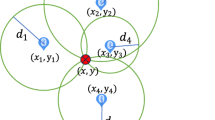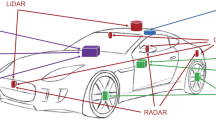Abstract
Localization is a crucial problem in wireless sensor networks and most of the localization algorithms given in the literature are non-adaptive and designed for fixed sensor networks. In this paper, we propose a learning based localization algorithm for mobile wireless sensor networks. By this technique, mobility in the network will be discovered by two crucial methods in the beacons: position and distance checks methods. These two methods help to have accurate localization and constrain communication just when it is necessary. The proposed method localizes the nodes based on connectivity information (hop count), which doesn’t need extra hardware and is cost efficient. The experimental results show that the proposed algorithm is scalable with a small set of beacons in large scale network with a high density of nodes. The given algorithm is fast and free from a pre-deployment requirement. The simulation results show the high performance of the proposed algorithm.























Similar content being viewed by others
References
Aspnes J, Eren T, Goldenberg DK, Morse AS, Whiteley W, Yang YR, Anderson BD, Belhumeur PN (2006) A theory of network localization. IEEE Trans Mobile Comput 5(12):1663–1678
Le TN, Chong PH, Li XJ, Leong WY (2010) A simple grid-based localization technique in wireless sensor networks for forest fire detection. In: Second international conference on communication software and networks, (2010) ICCSN’10, pp 93–98
Afzal S (2012) A review of localization techniques for wireless sensor networks. Text Road Publication ISSN, pp 2090–4304
Rudafshani M, Datta S (2007) Localization in wireless sensor networks. In: 6th International symposium on information processing in sensor networks, 2007. IPSN 2007, pp 51–60
Mourad F, Snoussi H, Abdallah F, Richard C (2009) Anchor-based localization via interval analysis for mobile ad-hoc sensor networks. IEEE Trans Signal Process 57(8):3226–3239
Nguyen X, Jordan MI, Sinopoli B (2005) A kernel-based learning approach to ad hoc sensor network localization. ACM Trans Sens Netw (TOSN) 1(1):134–152
Tran DA, Nguyen T (2008) Localization in wireless sensor networks based on support vector machines. IEEE Trans Parallel Distrib Syst 19(7):981–994
Huan R, Chen Q, Mao K, Pan Y (2010) A three-dimension localization algorithm for wireless sensor network nodes based on SVM. In: International conference on green circuits and systems (ICGCS), pp 651–654
Amundson I, Koutsoukos XD (2009) A survey on localization for mobile wireless sensor networks. In: Mobile entity localization and tracking in GPS-less environnments. Springer, Berlin, pp 235–254
Burges CJ (1998) A tutorial on support vector machines for pattern recognition. Data Min Knowl Discov 2(2):121–167
Letchner J, Fox D, LaMarca A (2005) Large-scale localization from wireless signal strength. In: Proceedings of the national conference on artificial intelligence, vol. 20, pp 15
Baggio A, Langendoen K (2008) Monte Carlo localization for mobile wireless sensor networks. Ad Hoc Netw 6(5):718–733
Shao Q, Xu H, Jia L, Li P (2011) The research of Monte Carlo localization algorithm based on received signal strength. In: 2011 7th International conference on, wireless communications, networking and mobile computing (WiCOM), pp 1–4
Xu J, Bu F, Si W, Qiu Y, Chen Z (2011) An algorithm of weighted Monte Carlo localization based on smallest enclosing circle. In: Internet of things (iThings/CPSCom), 2011 international conference on and 4th international conference on cyber, physical and social computing, pp 157–161
Xu Y, Chen X, Ma Y, Li Z, Huang L, Liu Y (2012) Heretic Monte Carlo localization and tracking algorithm for wireless sensor networks. In: Recent advances in computer science and information engineering. Springer, Berlin, pp 233–238
Pan JJ, Yang Q, Chang H, Yeung D.-Y (2006) A manifold regularization approach to calibration reduction for sensor-network based tracking. In: Proceedings of the national conference on artificial intelligence, vol. 21, pp 988
Kim W, Park J, Kim HJ (2010) Target localization using ensemble support vector regression in wireless sensor networks. In: Wireless communications and networking conference (WCNC). IEEE, pp 1–5
Lorincz K, Welsh M (2005) Motetrack: a robust, decentralized approach to rf-based location tracking. In: Location-and context-awareness. Springer, Berlin, pp 63–82
Pan JJ, Pan SJ, Yin J, Ni LM, Yang Q (2012) Tracking mobile users in wireless networks via semi-supervised colocalization. IEEE Trans Pattern Anal Mach Intell 34(3):587–600
Fan R-E, Chang K-W, Hsieh C-J, Wang X-R, Lin C-J (2008) LIBLINEAR: a library for large linear classification. J Mach Learn Res 9:1871–1874
Acknowledgments
The authors would like to thank the anonymous reviewers for their valuable comments and suggestions which improved the paper.
Author information
Authors and Affiliations
Corresponding author
Rights and permissions
About this article
Cite this article
Afzal, S., Beigy, H. A localization algorithm for large scale mobile wireless sensor networks: a learning approach. J Supercomput 69, 98–120 (2014). https://doi.org/10.1007/s11227-014-1129-6
Published:
Issue Date:
DOI: https://doi.org/10.1007/s11227-014-1129-6




